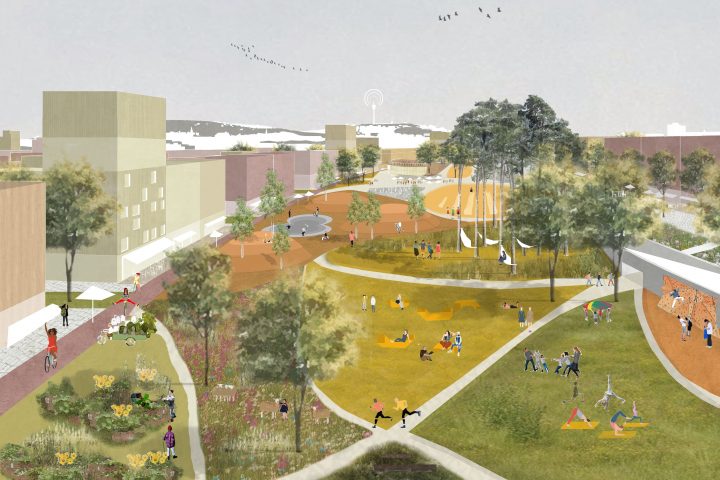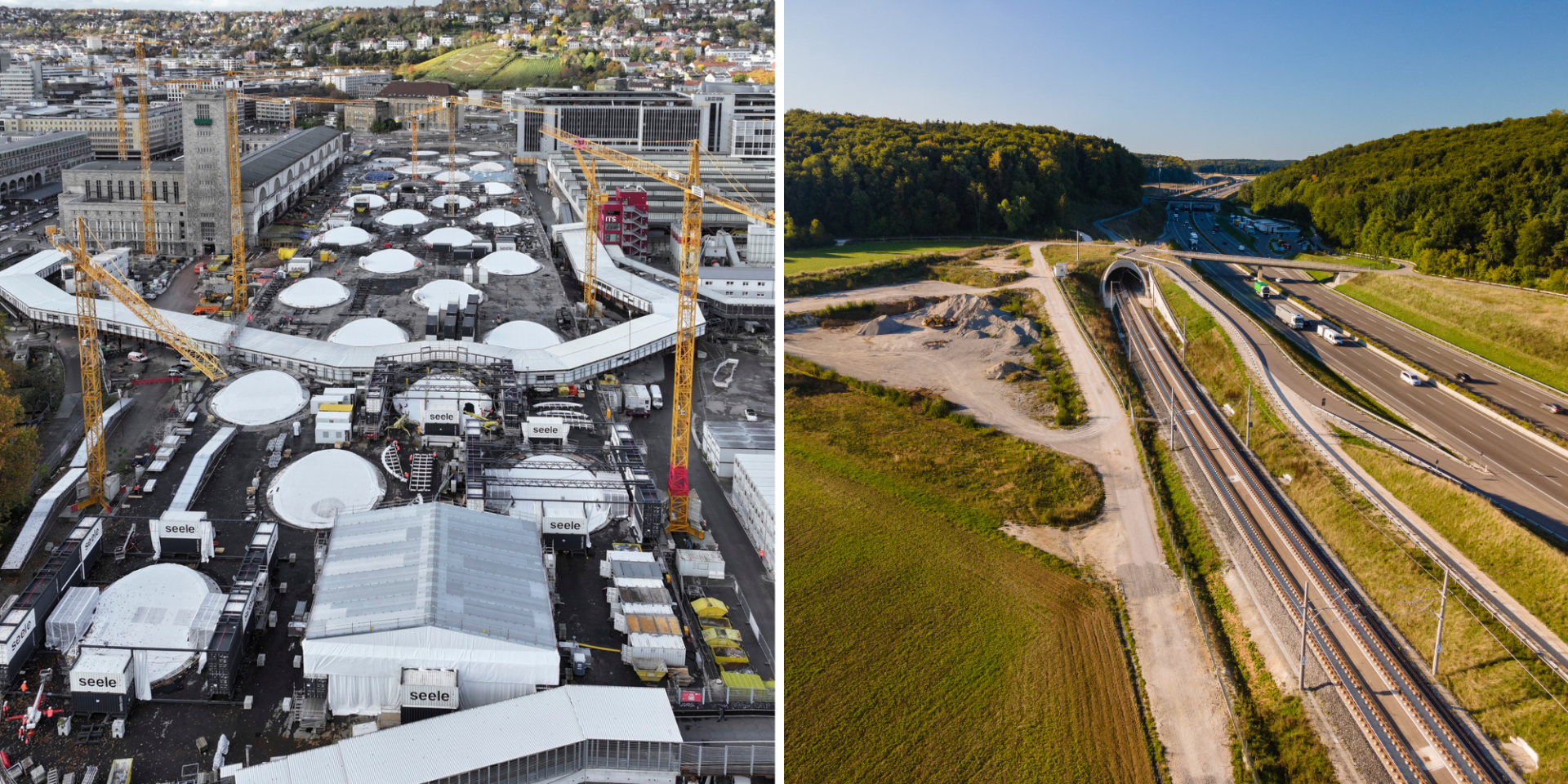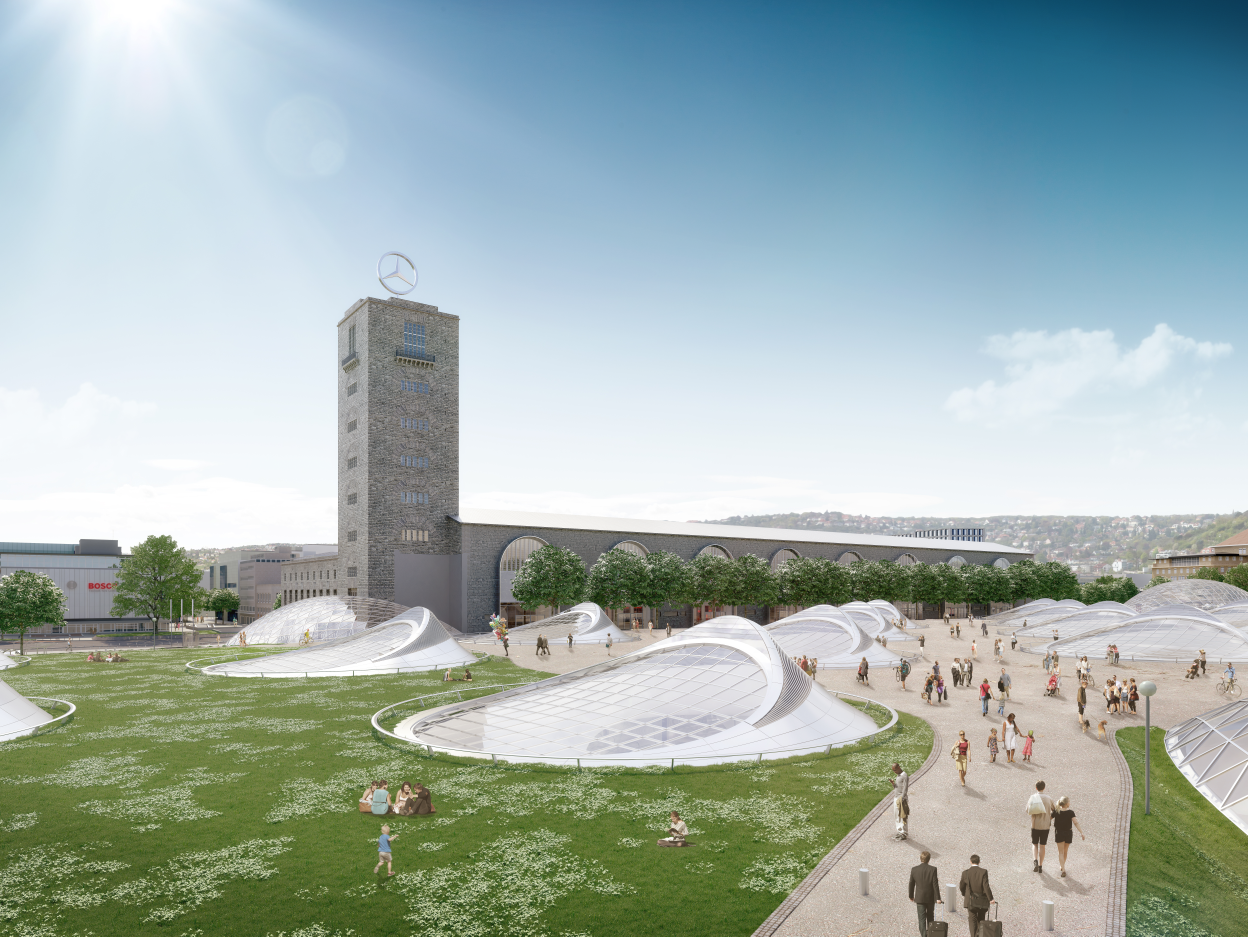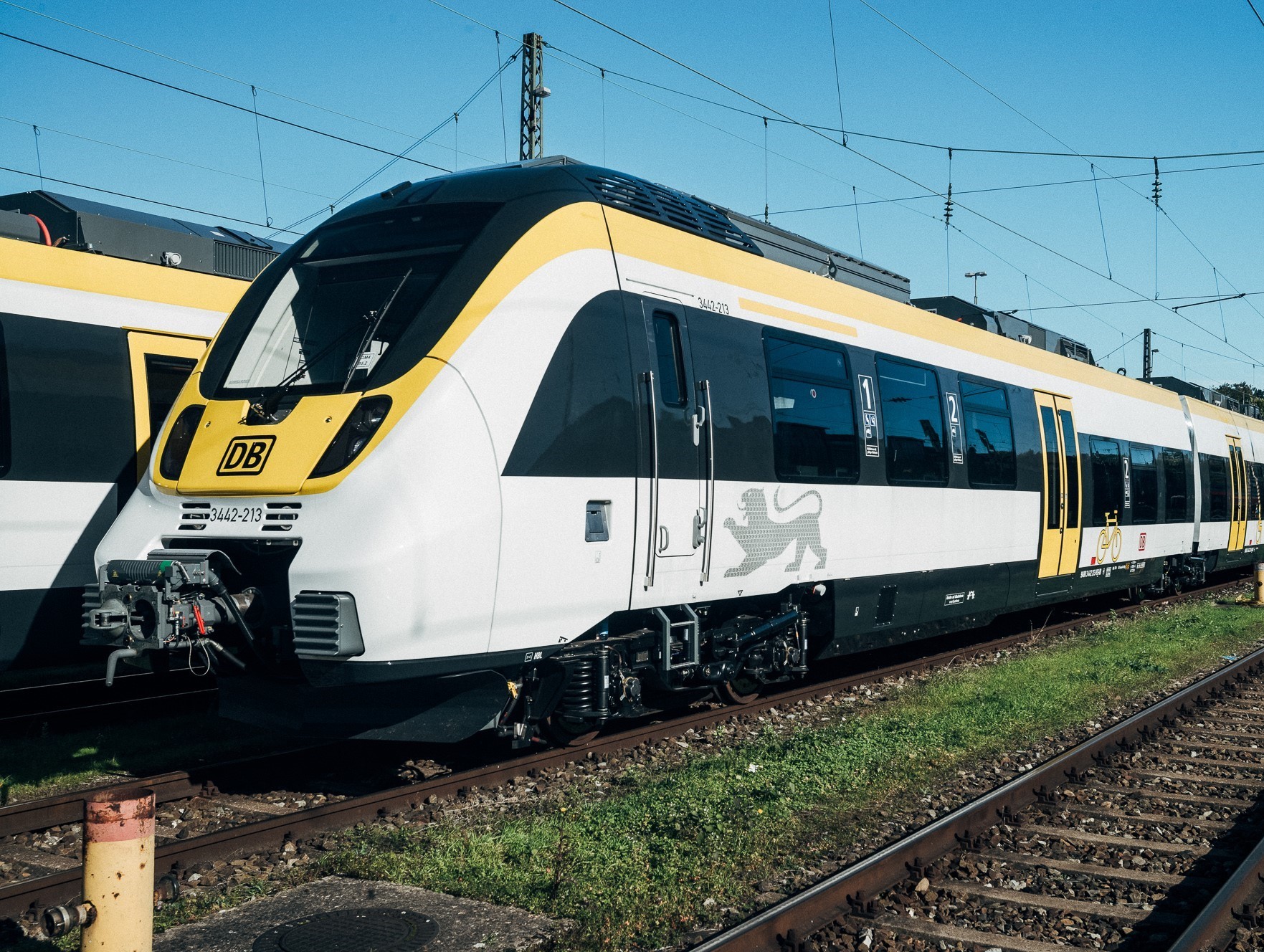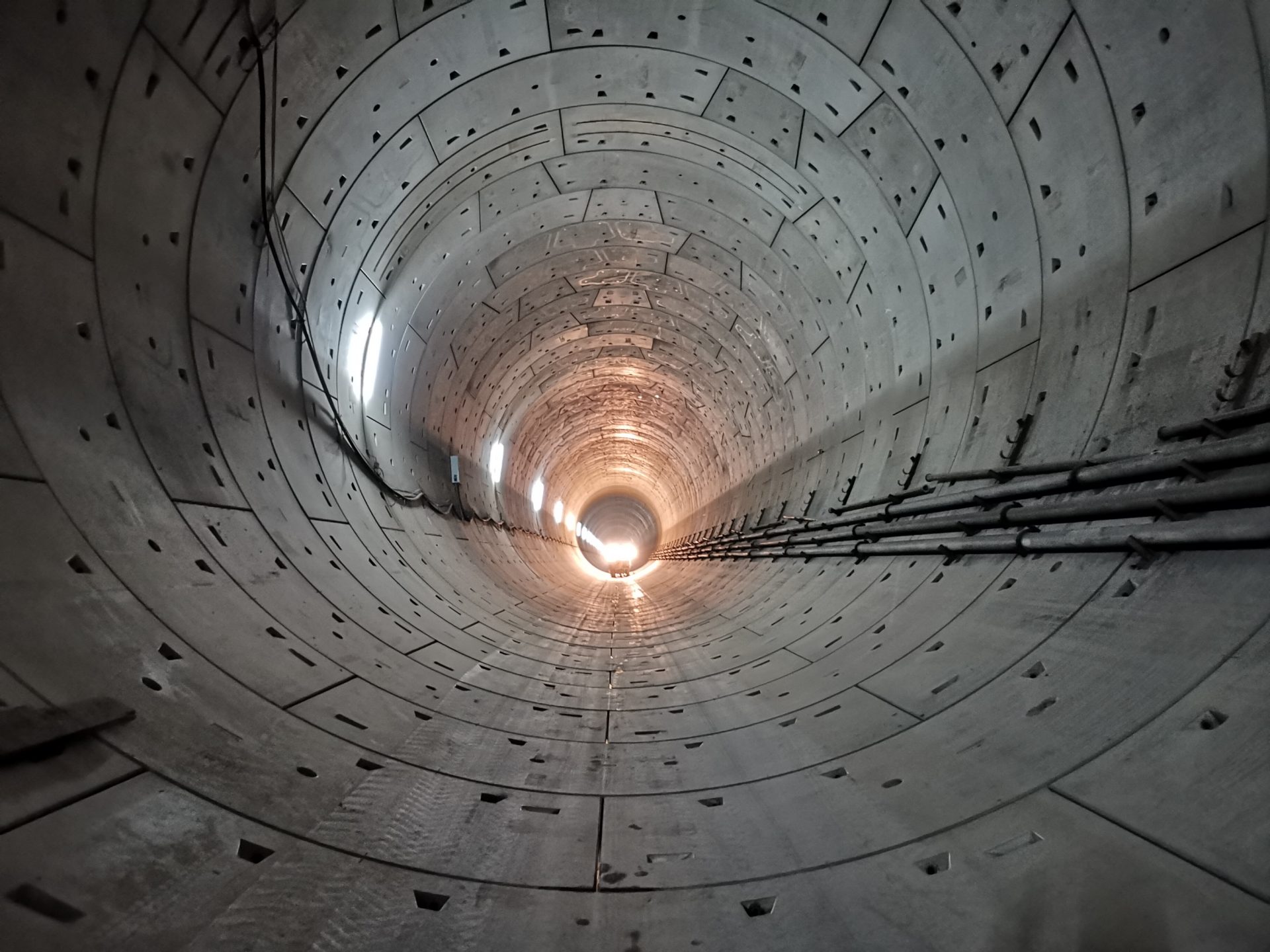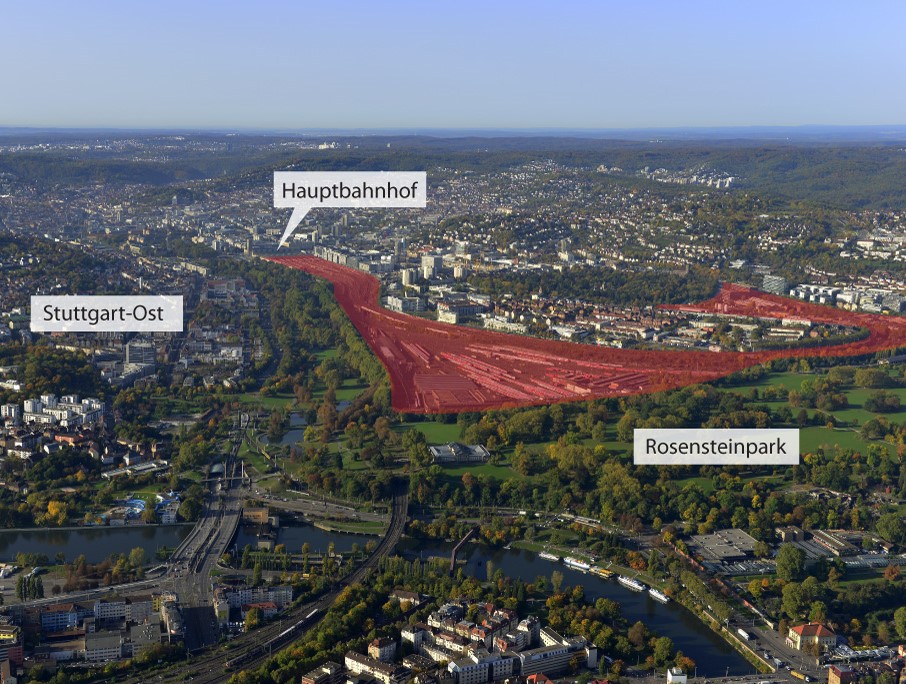Project facts
How efficient is the new Stuttgart through station? Are the tunnels safe?
Here you will find answers to important questions about Stuttgart 21 and the Wendlingen-Ulm high-speed line.
The rail project: facts and figures
The Stuttgart-Ulm rail project comprises two sub-projects: Stuttgart 21 and the Wendlingen-Ulm high-speed line.
A total of around 120 kilometers of new rail lines are being built.
STUTTGART 21
The Stuttgart 21 project is far more than the much-publicized reconstruction of the main train station. The entire Stuttgart rail hub is being reorganized. The rail network is being expanded in the process: Around 57 kilometers of track will be created for long-distance, regional and commuter rail traffic, around 30 kilometers of which will run in tunnels. Four stations will also be built as part of the project:
- The main station as a through station
- The train station at Stuttgart Airport
- The Mittnachtstraße S-Bahn Station
- The sidings station in Untertürkheim
To complement Stuttgart 21, Stuttgart-Vaihingen station has also been converted into a stop for regional trains.
Stuttgart's future main station is the centerpiece of the project. The terminus station will become a through station. This will be located at right angles to the current tracks at a depth of around eleven meters. The station comprises eight platform tracks on four central platforms. A predominantly underground rail ring connects the new station to the existing network. When the new station is completed, the above-ground tracks will be removed. A new urban district will be built on the freed-up space: Stuttgart Rosenstein.
HIGH-SPEED LINE WENDLINGEN-ULM
The Wendlingen-Ulm high-speed line is around 60 kilometers long. It provides a fast and comfortable route across the Swabian Alb. More than half of the route runs through a total of eleven tunnels. Large sections of the above-ground route run directly alongside the A8 highway. By bundling the two routes, the project uses less land.
At around 85 meters high, one of the highest railroad bridges in Germany has been built in the Filstal valley near Mühlhausen. A total of 37 bridges are part of the high-speed line.
On the old route over the Swabian Alb, trains sometimes have to slow down to 70 kilometers per hour. On the new route, however, they travel at speeds of up to 250 kilometers per hour. The Wendlingen-Ulm high-speed line went into operation on 11.12.2022. The travel time between Stuttgart and Ulm for long-distance services is The journey time via the high-speed line is around a quarter of an hour shorter than via the Filstal line. This will also benefit travelers between North Rhine-Westphalia and Bavaria, for example. At the same time, the daily long-distance service between the two state capitals of Stuttgart and Munich will increase by around 20 to 90 journeys. Thanks to the high-speed line, there are many new, attractive offers in regional transport: The new Merklingen - Schwäbische Alb station, for example, will open up an entire region for rail travel.
The high-speed line also relieves the Filstalbahn. The MEX service could be improved there. When Stuttgart 21 goes into operation, the high-speed line will be able to develop its full potential: The journey time between Stuttgart and Ulm will then be just 27 minutes for long-distance services.
THE NEW RAILWAY STATION: Comfortable, safe and efficient
Stuttgart's future main station is the centerpiece of the project. The terminus station will become a through station. It will be located at right angles to the current tracks at a depth of around eleven meters. It has eight tracks on four central platforms.
SHORT WAYS
It will be easier for passengers to get to their trains. The new Stuttgart main station can be reached from all directions via short and barrier-free routes. Passengers can reach one of the three distribution bridges at ground level or via elevatorslocated above the platforms. Three elevators, five staircases and seven escalators lead to each platform. The walkways shorten the time it takes to change platforms. The maximum distance from platform 1 to platform 8 is 200 meters. Each platform also has direct access to the S-Bahn. The shortest distance from platform 1 to the S-Bahn station Hauptbahnhof tief is just 50 meters.
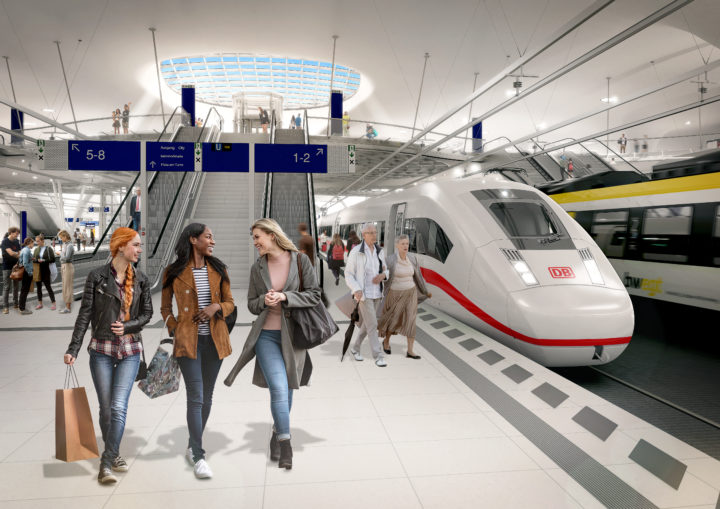
Visualization: plan b agency
PERFORMANCE
The new station is so efficient that it the politically stipulated doubling of passenger numbers compared to 2010 creates. This is a matter of minutes: The planned German cycle time can only be achieved with fast entrances and exits to the new station. With the 'Digitaler Knoten Stuttgart' pilot project, all trains, including the S-Bahn, are being controlled digitally for the first time. This is unique in Germany and is intended to set an example. It brings even more performance to the rails and helps to reduce delays.
In the new Stuttgart main station, a train can run every five minutes on each of the eight platform tracks in high-speed operation. An average train frequency of two minutes is possible on each of the eight adjoining tracks. This corresponds to around 100 trains per hour in the main station. That is more than twice as many as currently arrive at the congested terminus station at peak times.
FIRE PROTECTION
The fire protection concept for Stuttgart's future main station was developed by Deutsche Bahn together with experts from the Stuttgart fire department. It was comprehensively tested and approved. Based on the approved plans, new escape staircases will be built at the ends of each of the four platforms. All evacuation measures and the plans have been coordinated with the Dachverband Integratives Planen und Bauen e.V. (DIPB).
ACCESSIBILITY
The future main station is accessible from all directions via barrier-free routes. At ground level, travelers from Königstrasse, the main ticket hall or even from the palace garden can access the walkways. These are pedestrian bridges that connect the four platforms. Three elevators lead to each platform. The new station is especially designed to meet the needs of people with limited mobility and orientation difficulties. Deutsche Bahn has discussed its plans with specialist associations and is involving them in the implementation.
LENGTH TILT
The future main station has a longitudinal gradient of 13.1 to 15.1 per mille in the platform area. 15 per mille is no more than 1.5 cm difference in height per meter. This is compensated for by a transverse slope of the platforms toward the center amounting to 2 percent. This means that baby carriages and suitcases do not roll away, and there is no danger for passengers. The Federal Railway Authority has tested the platform slope and rated it as safe. The Feuersee S-Bahn station in Stuttgart, built in the late 1970s, has a greater longitudinal incline of 20 per thousand than the new station. It has been operated accident-free for 40 years.
ARCHITECTURE
The existing station building was built between 1914 and 1928 and is named after its architect Paul Bonatz. The "Bonatzbau" remains with the large hall as the reception building and the tower.
Christoph Ingenhoven is the architect of the new central station. His design integrates the "Bonatzbau" into the modern architecture. The trademark of the new station are 28 chalice-shaped columns. These form a unique concrete shell construction that has never been produced in this form before. Linked together, they form the roof of the platform hall. Over 1,000 square meters of formwork are used for each chalice support. There are 350 tons of reinforcing steel in a complete chalice. These are distributed over at least 22,000 individually measured steel struts.
ECOLOGY
In addition to their load-bearing function, the goblet supports also have a second function: 27 of them are fitted with around 200 m² of light eyes through which daylight falls onto the platforms. This largely eliminates the need for artificial lighting during the day and saves energy. Pleasant temperatures prevail in the platform hall all year round. Arriving trains and the cooling tunnel air flowing through provide the necessary air exchange. The soil around the platform hall releases heat and cold only slowly and has an insulating effect.
The trains: fast and digital
How do passengers benefit from the Stuttgart-Ulm rail project?
FAST, DIRECT CONNECTIONS
Thanks to the Stuttgart-Ulm rail project, passengers can travel faster and have to change trains less often.
Europe's metropolises are moving closer together
The new Stuttgart-Ulm axis is part of the "Magistrale for Europe. The name stands for a network of rails on which trains travel at high speed. It connects regions and large cities in five European countries. 34 million inhabitants and 16 million employees live there. The project is an initiative of the European Union (EU).
Stuttgart and Ulm are centrally located on this important route. It links Paris, Strasbourg, Munich and Vienna with Bratislava and Budapest along a route of 1,500 kilometers. The line is the central west-east connection in the European rail network. Its expansion is a contribution to the economic, political and cultural rapprochement of Western and Eastern Europe.
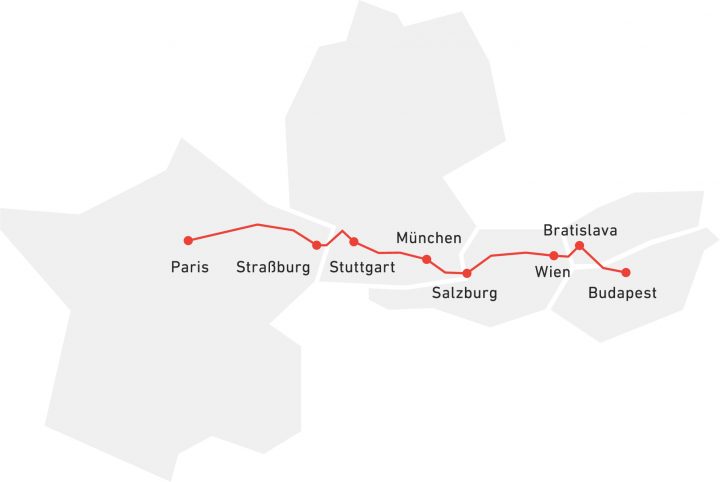
Baden-Württemberg: public transport benefits
The Stuttgart-Ulm rail project will improve rail transport in Baden-Württemberg overall: The implementation of the Deutschlandtakt is only possible with the rail project. This is about minutes in travel time. The major centers in Baden-Württemberg should only be less than 30 minutes apart. The new infrastructure will make many connections faster and more direct. Eight out of a total of eleven million inhabitants will benefit from the rail project. For example, because they live in districts that will be served by new, through regional rail services. The Stuttgart-Ulm rail project will also allow more trains to run. Travel times will be shorter and new direct connections will be created. The options for changing trains will be improved by coordinating long-distance and regional train lines.
Regions move closer together thanks to fast connections. In the future, it will be easy to live in Ulm and work in Stuttgart. This also applies to other regions in the country. Companies will also benefit: If they can be reached quickly and easily, they will find it easier to attract skilled workers.
Stuttgart Region: Travel faster and better
The current terminus station will become a through station. Trains will no longer have to change direction when leaving the station, but will simply continue their journey. This will make it possible to link transport lines that today end at the main station. Where passengers have to change trains today, they can simply remain seated in the future. This not only saves time, but also makes traveling by train more pleasant. Many cities will be accessible more quickly thanks to the rail project. This strengthens the economy and brings more quality of life.
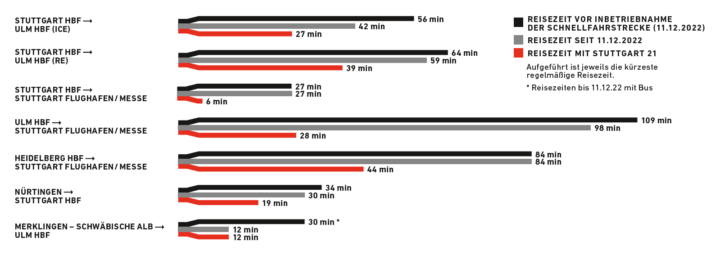
GERMANYTAKT
From 2030, twice as many people are to travel by rail as in 2010. One step towards this is a coordinated timetable for the entire country, the "Deutschlandtakt".
Many trains of different lines run at stations with important junction functions. Trains arrive at regular times. Such a timetable is easy to remember. For example, a half-hourly service for long-distance traffic is planned on the important Mannheim-Stuttgart-Ulm line.
The aim of the Deutschlandtakt is to ensure that long-distance and regional services are well coordinated. As this applies to the whole of Germany, it extends far beyond the commissioning of Stuttgart 21. However, the planned Deutschlandtakt requires Stuttgart 21. The current draft of the Deutschlandtakt envisages more trains than ever for the future Stuttgart main station: a basic service of a total of 33 long-distance and regional trains per hour. That is a third more than in December 2021 (25 trains per hour). This would not be possible without Stuttgart 21.
The new rail hub creates the conditions for the politically targeted doubling of passenger numbers.
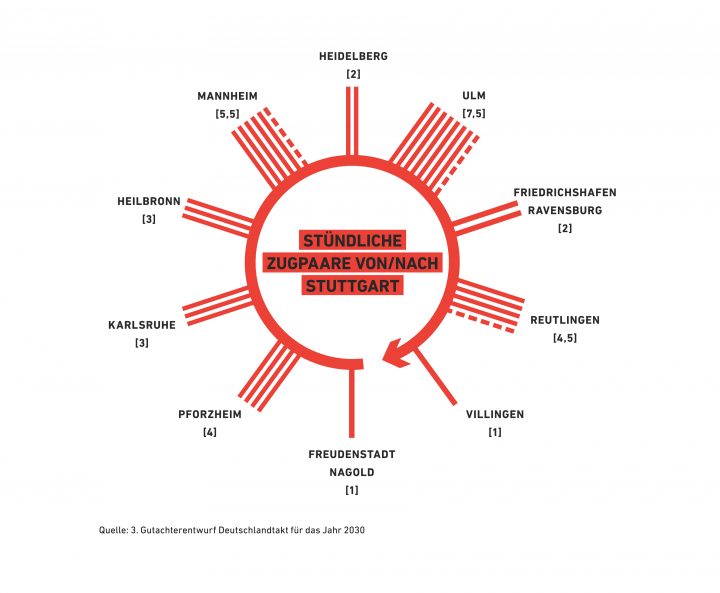
DIGITIZATION
DSD - Digital Rail Germany
The familiar signaling systems along the tracks are being replaced. Digital technology optimizes train traffic. It speeds up processes while ensuring maximum safety. This means that more trains can take more passengers to their destinations faster and more reliably at shorter intervals.
An important part of the digital technology is called European Train Control System (ETCS).
ETCS is a train control system. It monitors the progress of a train and prevents it from running over signals that indicate "stop". To do this, ETCS collects information from the track, from the trains and from the interlockings. Computers process the data and convert the result into instructions. ETCS is in use or planned in over 60 countries around the world. In combination with other systems, more trains run with fewer delays.
DKS - Digital Node Stuttgart
More reliable, more punctual, more efficient: the Stuttgart Digital Junction sets new standards in rail traffic. For the first time, a major German rail hub is being equipped with digital interlockings, ETCS Level 2 and other DSD technologies. When completed, the Stuttgart junction will not only include the new through station and the Stuttgart S-Bahn, but also the entire Stuttgart region and beyond. More than half a million passengers per day will then benefit from the digital technology and be able to travel better.
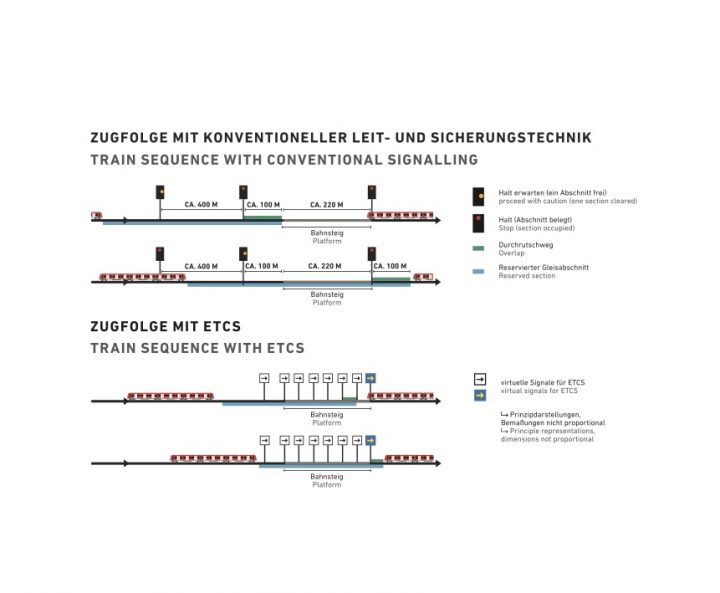
TRAFFIC HUB AT THE AIRPORT
A new station for long-distance and regional trains is being built between Stuttgart Airport and the Landesmesse trade fair center. From there, the journey to the main station in the city center will be shortened from 27 to 6 minutes. In addition, large parts of the country will be accessible from the airport station without having to change trains.
Benefit from this:
- ten million air travelers a year
- annually more than one million trade fair visitors as well as
- quarter of a million people in the catchment area of the new station.
The station for long-distance buses and a light rail link will create a transportation hub between rail, road and airspace.
![]()
METROPOLEX PRESS
Metropolexpress brings passengers faster to the city of Stuttgart and back to the countryside. The abbreviation for the Metropolexpress is MEX. The MEX stops at all stations outside Stuttgart and collects passengers. In the S-Bahn area, it then only travels to the main station with a few stops. The MEX lines run from Heilbronn, Schwäbisch Hall, Aalen, Geislingen, Tübingen, Horb and Pforzheim to Stuttgart. Between 5 a.m. and midnight, the MEX runs every half hour on almost all routes.
S-BAHN
The S-Bahn is the backbone of public transport in the region
The Stuttgart Region Association has been responsible for the S-Bahn since 1996. On eight lines, almost 950 S-Bahn trains travel to more than 80 stops every day. At peak times, they bring over 430,000 passengers to their destinations in a comfortable and environmentally friendly way.
People are mobile differently than they were a few years ago
Working people want to better combine family and career. Working hours are becoming increasingly flexible. As a result, more people are dependent on frequent service, even outside peak times. Commuters expect a variety of options for changing trains. The association is therefore expanding the S-Bahn network. Since 2017, it has expanded the timetable to an all-day 15-minute interval condensed. This was done in four stages. In December 2020, the last gap between 10 a.m. and 12 noon was closed. In 2023, the service was even extended to Saturdays. Currently, the S-Bahn service is somewhat limited due to the many construction sites and lack of staff.
In 2019, the association also decided to purchase 58 additional vehicles with an investment volume of well over 400 million euros. This will make S-Bahn transport fit for the future. Modern digital technology for train control (ETCS) will ensure more capacity and fewer delays in future. This technology is to be installed in the Stuttgart rail junction as part of the "Digitaler Knoten Stuttgart" pilot project. With ETCS, more trains can run at shorter intervals and thus bring more passengers safely and comfortably to their destination. The new technology will also help to ensure that some S-Bahn trains that currently terminate at Schwabstraße will in future run to Vaihingen and on to Böblingen.
The network becomes denser and better
Stuttgart 21 will also significantly improve regional transport services. Among other things, this will be ensured by the regional transport lines that will run through the main station in the future. They will create a transport system with numerous new direct connections, shorter journey times and better transfer options. The airport will be connected for long-distance and regional traffic and will become a new hub for traffic. The main line of the S-Bahn will be extended. There will be a new S-Bahn station, Mittnachtstraße, between the main station and Bad Cannstatt. All lines will stop at Mittnachtstrasse. Passengers changing trains, for example from the Rems and Neckar valleys to the north and vice versa, will have a much shorter journey in the future. The S-Bahn network will also continue to grow outward. Extensions to Neuhausen auf den Fildern and Nürtingen have been decided and are already in the planning stage.
More and more comfort
Since 2021, all S-Bahn trains in the region have gradually been given a new coat of paint, a modified interior and fresh technology. Instead of the classic red, the S-Bahn trains will arrive in light gray. Doors and special compartments are given clearly recognizable color elements. This makes boarding at stops easier and quicker. New additional multi-purpose compartments make it easier for people with wheelchairs, bicycles or baby carriages to travel. There are sockets for charging electronic devices everywhere on the train. New and larger screens provide information about the current location and journey time at all times. There is free WLAN on the trains. The passenger also receives about the Regio Guide also receives all travel information in real time on their cell phone, tablet or laptop.
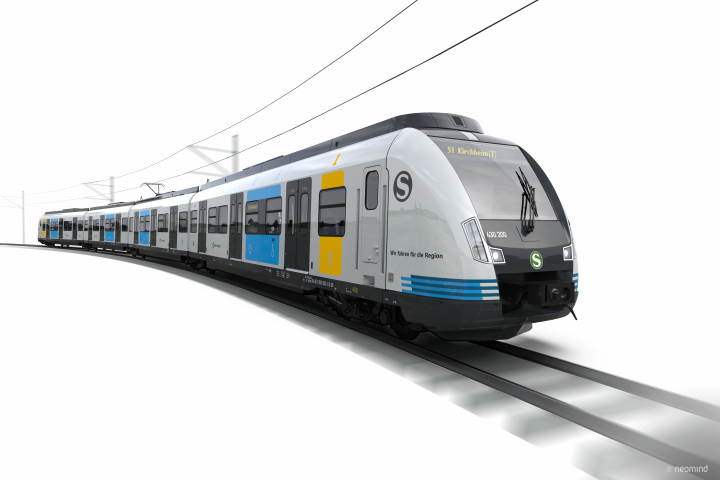
THE tunnel: safe and tested
Tunnel safety has top priority in the Stuttgart-Ulm rail project.
Deutsche Bahn has a four-stage safety concept for tunnels:
PREVENT
The probability of a train having an accident in a tunnel is minimized from the outset. How does this work? By eliminating, for example, encounters between two trains in a tunnel as far as possible or completely. In new tunnels, such as those of the Stuttgart-Ulm rail project, this is mainly achieved by building two separate tunnel tubes. This means that a separate tube is available for each direction of travel.
MINDERN
If something should nevertheless happen in the tunnel, the aim is to minimize the effects of the damage. This includes, for example, the "emergency brake override". This enables the train driver to override an emergency braking maneuver in the event of a fire in the tunnel, for example, so that the train can continue its journey and leave the tunnel without stopping. Further measures can then be carried out outside the tunnel.
SELF RESCUE
In the event that a train nevertheless comes to a stop in the tunnel, escape routes with escape guidance systems are available. Between the single-track tunnel tubes of the Stuttgart-Ulm rail project are connecting structures through which people can reach the other tunnel tube. One tube is the safe space for the other tube.
FREME DESTRUCTION
The fire departments and emergency services can drive through the parallel tunnel with rescue vehicles to the scene of the accident and provide assistance from there. For this purpose, all the necessary facilities are available to them in the vicinity of the portal, such as rescue sites with access roads and fire water supply.
The city: green and climate-friendly
The rail project opens up an urban development opportunity of the century: 85 hectares of land for a new district in the heart of Stuttgart.
THE NEW DISTRICT OF STUTTGART ROSENSTEIN
The completion of the through station opens up a unique opportunity for the state capital Stuttgart. 85 hectares of land will become available. A new city district is to be built there: Stuttgart Rosenstein. Three districts are to be created. They are called Europaquartier, Rosensteinquartier and Maker City. A new park, Gleisbogenpark, is also planned. This green space will connect the three districts. Affordable living space will be created in all districts. Businesses and small production facilities can also set up here, as well as cafés and stores for everyday needs. There will also be schools, daycare centers, sports and play areas, green spaces and cultural and social meeting places.
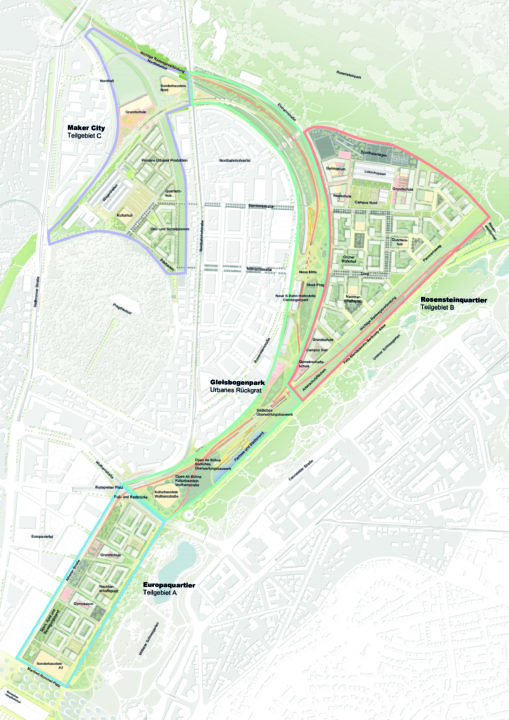
HOW SHOULD STUTTGART ROSENSTEIN BE STRUCTURED AND DESIGNED?
The winning design of the urban planning competition for Stuttgart Rosenstein was created by the asp Architekten and Koeber Landschaftsarchitektur consortium. Based on this design, the city of Stuttgart developed the framework plan for Stuttgart Rosenstein. The citizens of the city were also closely involved in this process. Suggestions from public participation were incorporated into the planning.
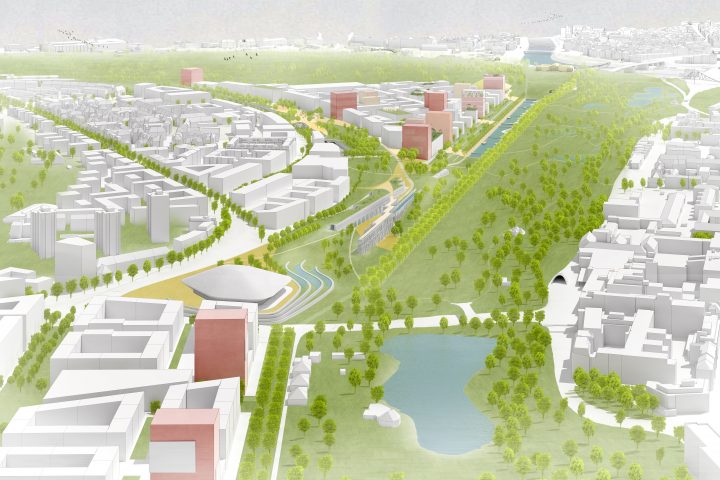
THE VISION FOR STUTTGART ROSENSTEIN
Urban and mixed, social and lively, networked and climate-adapted - this is how Stuttgart Rosenstein should feel. The mission statement defines the character of Stuttgart Rosenstein. Living, working, learning and cultural experiences merge seamlessly and are no longer viewed separately. The supposed opposites are considered as a whole and lead to a far-reaching mix of uses at all (district) levels. This includes a well thought-out use of space and selection of the right, sustainable building materials, a sustainable mobility mix including infrastructure and consistent greening of the district, not just on facades and roofs. The result is a place to live that connects needs, shortens distances and creates a new form of identification. As a result, Stuttgart Rosenstein will become a district with completely new opportunities for private, communal and economic life.
Mission statement
Urban + mixed:
- Design Stuttgart Rosenstein based on existing structures and develop places with identity.
- Creating a lively quarter with a colorful and open mix of uses.
- Design green and open spaces as a whole in a diverse and multicoded way.
Social + lively:
- Creating a balanced mix for social cohesion and vibrant diversity.
- Shaping change in a way that is oriented towards the common good, open and needs-oriented.
- Creating equal living conditions for all.
Networked + climate-adapted:
- Developing a climate-resilient and green neighborhood - for people and nature.
- From separately used street spaces to shared movement spaces - the focus is on people.
- Reduce resource consumption through the circular economy.
